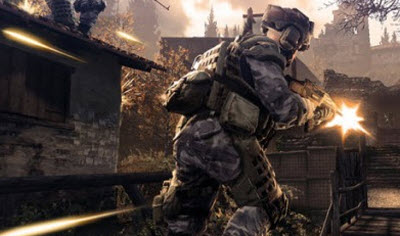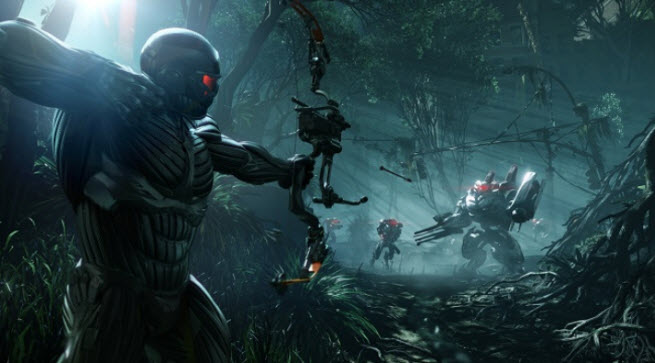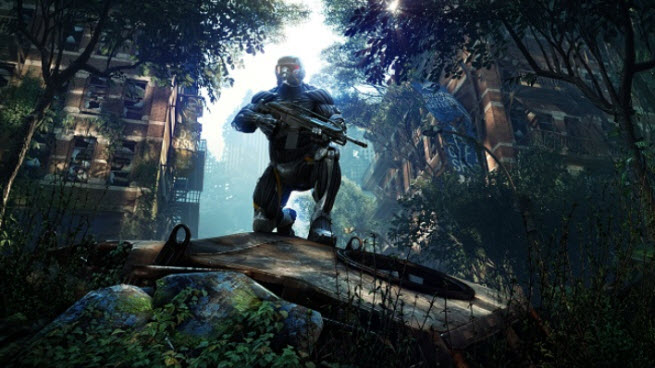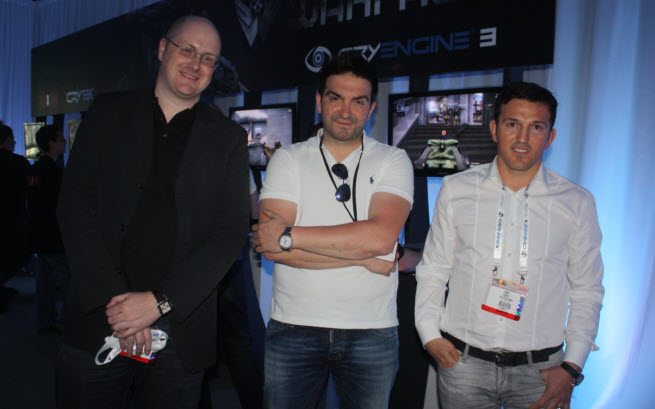Crytek prides itself on on creating the highest-quality 3D graphics in its games, from the original Far Cry to today’s upcoming title, Crysis 3. The Frankfurt, Germany-based game developer also makes the CryEngine, which serves as the foundation for a number of high-end 3D games. At this year’s Electronic Entertainment Expo (E3), the company showed off its Crysis 3 game and the downloadable free-to-play title Warface, which is expected to be published by Trion Worlds. With each game, the company is pushing the cutting edge of graphics in video games. Crytek is also working on its own social entertainment platform, dubbed GFACE.
We sat down for an interview with Anvi Yerli (right), managing director; Cevat Yerli (middle), managing director; and Nick Button-Brown (left), general manager for games. Cevat Yerli said that CryEngine already can handle the kind of graphics demonstrated by Epic Games with the new Unreal Engine 4, and Yerli hinted at great things coming for the engine and for cloud graphics. Here’s a transcript of our interview.
 GamesBeat: Tell me more about Warface. Why is free-to-play interesting?
GamesBeat: Tell me more about Warface. Why is free-to-play interesting?
Button-Brown: Well, so we started looking at free-to-play in 2006. We were looking at what was happening in free-to-play in Korea. We thought it was a really interesting way of bringing a game to people, allowing people to play it for free and to purchase virtual goods. What a revolutionary idea. We started working on Warface not that long afterwards. Warface has been in the works for more than three and a half years. In that time, it’s become a model that works in other countries as well. We’re really proud of what we’re doing with Warface. We think we’ll bring a really high quality game to free-to-play.
Anyi Yerli: When we had visitors for the first time from Korea, in the year 2001, 2002, like XL Games and NCSoft, with Lineage and such, they came to our office and brought an interesting range of technology. Then they talked about how big the community is, and how big their user base is — the community was over 10 million — we were completely shocked by that. Where does this number come from? It was unbelievable. So that was the first time we made contact, when we got in touch with free-to-play. But then we continued our own development on Far Cry and Crysis. And then in 2006 we went out to Asia, and basically try to understand what’s going on. It was primarily in Korea, actually, trying to understand what works there, and understand why it works, how those games work, what kind of models they were applying. This was back in 2006. And then we started, basically, the roots of Warface at around the end of 2007. And we started thinking about the strength of the model, what makes this model unique, why is this so big?
Cevat Yerli: When we saw that, we thought, this is the future. Not what we’re doing, what they’re doing. The quality isn’t there, but the way they were doing it, that was the future. For us, at that time, the concept of GFACE was born as well. GFACE is our social entertainment platform. It’s a new kind of platform for entertainment, for gamers who want to play with their friends together. They want to play live games in real-time. They want to be free-to-play. So the concept of this was born, and we designed this over the last few years. In time there was Warface. To make Warface a launch title for the platform. It was a big learning curve for us, but when we launch it, both Warface and GFACE, we want to be sure that it shows how we think triple-A games will be experienced in the future. In a new kind of platform.
 GamesBeat: How are you distinguishing between, say, the quality of this, which looks good, versus something like Crysis? A $60 game versus a free-to-play game?
GamesBeat: How are you distinguishing between, say, the quality of this, which looks good, versus something like Crysis? A $60 game versus a free-to-play game?
C. Yerli: The central difference comes from the fact that Warface is actually a multiplayer game first. If you look at any multiplayer game, on console or PC, the multiplayer part is usually slightly lower-quality than the single-player parts. That is because in single-player you only have yourself, and you can put more action around you. In multiplayer, you have so much more going on with real humans, every game in multiplayer must be sort of lower-quality. So in Warface, because everything is online, the co-op player versus environment experience as well as the player versus player experience.
It is triple-A quality, but it’s still lower than your typical single-player game. But it’s on par with your multiplayer games. At least that’s our aim and vision. But at the same time, the most important part is that we need to run on as many PCs as possible. So it can hit six years of specifications. The last six years, if you bought a PC, you can run the game safely. Unlike Crysis 3, or Crysis 1 back then, which was pushing the limits, pushing the limits, moving forward. With Warface, we don’t push the limits on specs, but we do push the limit of what we can do within the specs. The GFACE platform is designed to be a destination for everybody who wants to play games. And Warface does not compromise that by requiring a frictional engine barrier, but rather it says, because the specs are so low. The friction is reduced by the price, the specs, and by the accessibility of the game.
GamesBeat: And why work with Trion on this one?
C. Yerli: Trion has, first of all, they have…
Button-Brown: We’re not talking about the partnership yet… [lots of embarrassed laughter] We’re expecting to talk about the partnership in a bit more detail next week. We have approached it, it’s not a traditional publisher-developer relationship. We wanted to bring it to western users in a slightly different way.
A. Yerli: So let’s say it this way. What I can say is, it’s an eye-to-eye level partnership. And it revolves around each company’s strengths. Which are very synergistic. And also, each of us around Warface, launching Warface and GFACE, our social network platform…
Button-Brown: We want to bring Warface to the market and give people the best experience. But we’ll talk about it next week.
A. Yerli: And we want to make sure it runs through GFACE.
GamesBeat: It sounds like they have some useful infrastructure, basically…
C. Yerli: They have the expertise, and…
Button-Brown: They have a lot of really talented people. And that’s what it comes down to, is talented people.
C. Yerli: It’s a very different level of cooperation, and hopefully it’s something that will be a benchmark going forward for others.
A. Yerli: I think the relationship that Crytek and Trion will portray will be a model going forward. And from a quality perspective, it will elevate the potential of how online games should be perceived. Something that both of us wouldn’t be able to do without each other in such a short amount of time. There’s not much left… [laughter]
C. Yerli: We just dance around the whole thing right now.
GamesBeat: How does Warface evolve over time? Is it as much a service as it is…
C. Yerli: Absolutely. Warface is an ongoing live service. We’re just starting it. We’ll be starting in Russia. It’s commercial. China is getting a closed beta now. So we’ll do Korea soon. We have a business plan for the next five years, on PC and mobile and tablet, for Warface. This is a business strategy, it’s not just a game strategy.
 GamesBeat: When it comes to 3D graphics now, I sort of… I don’t know what distinguishes the different engines and the different platforms here, but…
GamesBeat: When it comes to 3D graphics now, I sort of… I don’t know what distinguishes the different engines and the different platforms here, but…
Button-Brown: So our engine is the best… [chuckles]
GamesBeat: My eyes kind of tell me what I like. So Crysis 3 looks good. But Unreal Engine 4 looks good too. If you were to put some of these engines side by side, to me, I’m not sure I could tell what’s better. What can you explain about what makes yours better?
C. Yerli: The only thing I can say is that CryEngine 3 already exists at the quality of Unreal Engine 4. It already exists for three years now. You can go back three years ago to the GDC videos. What we put out there is pretty much what Unreal Engine 4 put out now. And what many others are doing now too. We haven’t really put out our latest stuff yet.
Pretty soon you’re going to see the next iteration of CryEngine, and I’m not putting a number behind it, just the next iteration of CryEngine. Very soon. But we already said, CryEngine 3 is next-gen ready since three years ago. We stand by that. If I look at what people call next-gen technology now, it’s what we were seeing three years ago. We already had massive particle systems, we already had GPU rendering, all these things. Deferred shading. We had tessellation already since we shipped Crysis 2. We already had DX11. We didn’t just talk it up as tech demos, we have games that are shipped and are doing it.
GamesBeat: As you go down this road, do you think that consumers are going to be able to tell these differences?
C. Yerli: There are tangible differences, but not in still images. It’s in the fluidity of the overall experience. It’s like you watch an Android phone and an iPhone. The iPhone, despite the fact that most Android phones can do the same things, just feels different. It feels more fluid, more organic on an iPhone. And similarly, with an Android, there are different limitations on an Android. One feels choppy, another feels better. Really, it’s not just about ticking off boxes next to features. It’s a holistic experience that has to be fluid and flawless and real. Not show. It must be real. That’s us and what CryEngine always stands for. It was always a very substantial, robust, polished experience that gamers will see. And I also think that we are dedicated to online games. When you look at our number of licensees in that space, we have more licensees than any other engine in the online space. In the console space it’s a different story. In the console space we’re definitely not leading. But I think the next time around, it’s going to be a very different picture.
GamesBeat: Is there a way to describe what you expect next-generation graphics to look like?
C. Yerli: Maybe one thing to add to this, actually. I think the biggest difference here between the engines is still the productivity. We have invented, back in 2001, what we called “what you see is what you play,” which is real-time editing of the game in the sandbox using the production tools. We did this in 2001, we put out a video at GDC 2001, and since then it’s been the heart of our technology. That’s something that even until today, our competitors, our main competitor, has still not 100 percent achieved. We’re talking about 10 years later, still not achieved. Some other competitors, when they started from scratch five years ago, they of course started from scratch with better ideas. Not a better idea than us, but a better idea than Epic. So in productivity and efficiency, it’s something where we claim we’re the fastest toolkit around. Because we’re 100 percent real-time. We’re the only engine that is 100 percent real-time. Look at our competitors and you will feel that every time they change a light or a shadow, it computes for hours. In our case, the lighting is real-time.
GamesBeat: For developers:
C. Yerli: For productivity, right. You can see the change in real time. It’s a huge iterative gain. And that’s true for everything, whether it’s our AI paths, navigation systems, our lighting and shadow systems, everything is real-time in CryEngine. Nothing is pre-baked.
GamesBeat: And that makes the difference as to whether you need 500 artists or a much smaller number to make a game?
C. Yerli: It can make productivity better. It can make your ideas come to concept better, you can test faster, you don’t have to wait for your modifications until tomorrow morning to see it. You can just see it. You don’t need a render farm or a lighting farm or a pre-baking farm. The artists just see the results right away. That’s a big difference, being real-time. And when you talk about next-gen graphics, what will define next-gen graphics. It’s definitely going to be about tessellation. It’s going to be about better lighting. We claim we have the best lighting. I think we’ll push it further, another notch. You will see animation quality make huge gains. And more realistic surfaces. As in materials like metals or wood, copper… Aged materials. This kind of realism will be playing a big focus in the next generation. And higher resolution texturing, like in the film industry, where you have effectively no limits on texture sizes. In the games, you used to have 256 by 256 textures, those limits will go up to…pretty much as much memory as you have in your PC. The new texturing will become a big topic as well.
 GamesBeat: So like Pixar quality, I guess…?
GamesBeat: So like Pixar quality, I guess…?
C. Yerli: I think we are going to be very close soon to rendering computer-generated (CG) film quality. I’m not necessarily pointing to Pixar. But we will, very soon, be able to render out film CG quality rendering in real-time. In the next two years.
GamesBeat: That’s a big deal.
C. Yerli: I said already a couple of years ago, we’ll be able to do Shrek-quality graphics in 2012, and we can today. In 2008 I gave a speech on the future of computer graphics, I said in 2012 we’ll have Shrek quality, and today we are Shrek quality. I think in two years more… But then again, film will be further head as well. And then we’ll catch up again. It’s going to be like that for a while.
GamesBeat: It seems like there’s a lot of different vectors for trying to make things look good.
C. Yerli: Yeah, yeah. At the end of the day, it’s not about being realistic. It’s about being believable and emotionally rich. If you believe in the world you’re in, and you believe in the characters you perceive, and believe that what you do has a consequence in a realistic way. So you can buy in to the world of the game. That’s the ultimate vision. The quality, the higher it gets, the easier it is for you to immerse in it. The barrier gets lower.
For the mainstream market. I would say that the better the quality gets on our games, the more mainstream gamers are going to come into this world and accept the richness of our content. Because when they go to a film, they see it. And when they see a game they ask, why doesn’t the game look like a film? They don’t understand… Most people don’t understand. And most people don’t care about it. To reach the same kind of critical mass as film, where we take hundreds of millions of potential viewers, like DVD and whatnot. To get that kind of volume of consumers, I think it’s where the quality has to increase. And yeah, some people do it with a lot of things happening on the screen. Some people do it with focusing on one thing, making it the best thing ever. Some people focus on environments, making those the best believable worlds, fantastic worlds, so you can immerse yourself.
GamesBeat: What about the advances in cloud gaming and Nvidia’s newest cloud graphics effort? Are those getting interesting for you?
C. Yerli: Yeah, we have been talking to Nvidia for a long time about that. They were talking about cloud gaming three years ago, the first touch points as far as what we want to do and how we could collaborate and things like that. But that being said, we cannot talk about that relationship at this moment. What and how and if we’re doing something with Nvidia. But it certainly was already mutually inspirational for the both of us, many years ago. Cloud gaming is not a new topic for us internally. It’s been a project of ours, and there is…a CryEngine cloud per se…
 Button-Brown: [begins Coughing Suggestively]
Button-Brown: [begins Coughing Suggestively]
C. Yerli: I did it already. It’s already out.
Button-Brown: I can start talking about it! Excellent.
C. Yerli: I just announced CryEngine cloud!
GamesBeat: Does that have a parallel sort of high-quality single-player, lower-quality multiplayer, and then cloud quality, I guess…? Is it harder to do high-quality graphics on…
C. Yerli: No, cloud quality will be up there. The CryEngine cloud philosophy is, how do you offer the best visuals at the lowest friction barrier, with the most efficient cost? So low friction, low cost, highest quality to the user. It’s really about the user benefit. And with this CryEngine cloud platform, the way we see it, it’s going to be tied into GFACE, our social hub. And it’s going to be very different from Gaikai or OnLive. Very different.
GamesBeat: As I remember, Trion has online gaming infrastructure, but they don’t call it cloud, because they’re not streaming, right? They’re doing the computing at the client. So to you, what does cloud mean? Does it mean computing in the data center, or computing partly in the client?
C. Yerli: Time will tell. [laughter]
Button-Brown: Yeah, that much we’re not announcing yet. We have something cool in the pipeline.
GamesBeat: So then it seems like there’s a variety of cloud architectures.
Button-Brown: Well, “cloud” means something very different depending on the context. People use “cloud” to mean a huge variety of things.
C. Yerli: Some people say “cloud” is just downloading a game and that’s it. Apple’s App Store is a cloud for some people. But it’s way beyond storage, for sure. And from a user experience perspective, it’s got the highest quality and easiest possible… From the company perspective, it’s to provide the user the highest quality at the cheapest per-user cost. This is our friction. The cost factor doesn’t work out on OnLive or Gaikai.
GamesBeat: So what seems attractive about it? Self-publishing is a lot easier…
C. Yerli: Yes. You touch your consumer and you deliver to your consumer directly. And most of the friction goes away. But friction starts, not just from the content experience, but also the platform itself. So GFACE has been designed to be as easy and simple as possible to get your friends together to play a game. And then change it into another game and another game and watch a movie and listen to something together and then finish the day. So this isn’t trying to be a Facebook, by the way. This is trying to be a platform, akin to Xbox or PlayStation. It’s just not a hardware platform. We are seeing this cloud platform, its interface is called GFACE. And Warface has CryEngine cloud, that in total gives you a very simple experience and a high-quality content experience.
GamesBeat: So are you liking the PC or the consoles right now.
C. Yerli: Right now we like both.
Button-Brown: We like tablets, too. We like mobile.
C. Yerli: We like iOS, we like Android… We are a content developer. We do technology as well, that’s CryEngine and CryEngine cloud. But we also have a platform, that’s GFACE, and GFACE will sit on iOS devices, Android devices, on the PC, and hopefully also the consoles as a software layer, a software platform.
![]() GamesBeat 2012 is VentureBeat’s fourth annual conference on disruption in the video game market. This year we’re calling on speakers from the hottest mobile, social, PC, and console companies to debate new ways to stay on pace with changing consumer tastes and platforms. Join 500+ execs, investors, analysts, entrepreneurs, and press as we explore the gaming industry’s latest trends and newest monetization opportunities. The event takes place July 10-11 in San Francisco, and you can get your tickets here.
GamesBeat 2012 is VentureBeat’s fourth annual conference on disruption in the video game market. This year we’re calling on speakers from the hottest mobile, social, PC, and console companies to debate new ways to stay on pace with changing consumer tastes and platforms. Join 500+ execs, investors, analysts, entrepreneurs, and press as we explore the gaming industry’s latest trends and newest monetization opportunities. The event takes place July 10-11 in San Francisco, and you can get your tickets here.
VentureBeat's mission is to be a digital town square for technical decision-makers to gain knowledge about transformative enterprise technology and transact. Learn More

